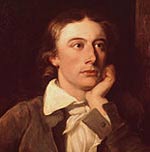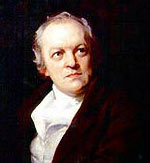John Keats was an influential Romantic poet, who has become one of the most widely respected and loved British poets.
“Beauty is truth, truth beauty, — that is all
Ye know on earth, and all ye need to know.”
– John Keats, Ode on a Grecian Urn.
Short Bio John Keats

When he was young, Keats lost both his father (aged 8) and later his mother (aged 14). Orphaned at an early age, Keats and his siblings were looked after by their grandmother. It also placed the family in a difficult financial situation – Keats would struggle with money throughout his life.
Job as surgeon
Having finished school, Keats took an apprenticeship at Guy’s Hospital, London in October 1815. In the early nineteenth century, the job of a surgeon was very challenging; in the absence of anaesthetic and modern technology, there was only a limited amount doctors could do to ease the condition of patients. This suffering of patients and people was a theme Keats would later incorporate into his poetry.
Life as a poet
It was hoped that this medical training would give Keats a secure career and financial income. However, in 1816, despite making good progress, Keats told his guardian that he couldn’t become a surgeon and felt compelled to try and make a career as a poet. It was a decision that his guardians failed to understand because, at the time, there was little hope of making money from writing poetry.
However, Keats was introduced to some of the leading literary figures of the day, such as Leigh Hunt, Percy Shelley and poet John Hamilton Reynolds. This enabled him to publish his first collection of poems, but they were not a critical success and sold very few copies.
From 1817, John spent considerable time nursing his brother Tom, who was suffering from tuberculosis. In 1818, they went on a walking tour of northern England and Scotland. His brother’s conditions deteriorated, and, weakened by cold himself, it is likely that John Keats contracted the ‘family disease’ of tuberculosis.
Despite the difficulty of his nursing his dying brother and suffering a series of financial difficulties, Keats began his most prolific period of writing. Based on the edge of Hampstead Heath he composed five of his six odes.
My heart aches, and a drowsy numbness pains
My sense, as though of hemlock I had drunk,
Or emptied some dull opiate to the drains
One minute past, and Lethe-wards had sunk:
’Tis not through envy of thy happy lot,
But being too happy in thine happiness,—
That thou, light-winged Dryad of the trees,
In some melodious plot
Of beechen green, and shadows numberless,
Singest of summer in full-throated ease.
First stanza of “Ode to a Nightingale”, May 1819
Around this time, he also met with the great poet William Wordsworth and Charles Lamb.
Publishing of Endymion
In 1818, his great work Endymion was published, however, many reviews were highly critical of Keat’s ‘immaturity’, it was labelled by some, including Byron as ‘Cockney Poetry’ – suggesting the poet used uncouth language. The edition sold very few copies, leaving both Keats and the publisher with a feeling of shame. Despite this critical failure, Keats gave an indication he strove only for genius. He did retain a faith in his poetry. As he writes:
“I was never afraid of failure; for I would sooner fail than not be among the greatest.”
Letter to James Hessey (October 9, 1818)
Despite the support of some literary friends, this critical review left a profound mark on Keats. Throughout his short life, he felt he had been a failure, unable to leave any lasting mark on poetry. On his deathbed, he would later write scathing letters saying perhaps he should have sold out to mammon (money) rather than pursue the purity of his poetic journey. In his last letter to Shelley, he writes bitterly:
“…A modern work it is said must have a purpose, which may be the God – an artist must serve Mammon – he must have “self concentration” selfishness perhaps. .. ”(16 August 1820) [link]
In this last letter, Keats also describes his personal view:
“My imagination is a Monastery and I am its Monk.”
(16 August 1820) [link]
John Keats and Fanny Browne
In 1818, he first came into contact with Frances (Fanny) Brawne. She was 18 at the time, and a close friendship arose between them. However, the relationship was overshadowed by Keats’ nursing of his brother Tom; also the lack of finance meant that Keats had no realistic chance of being able to marry. They wrote many intimate letters, in which Keats often bared his soul and the depth of his feeling:
“My love has made me selfish. I cannot exist without you — I am forgetful of every thing but seeing you again — my Life seems to stop there — I see no further. You have absorb’d me.”
The relationship was also cut short by the aggravation of Keat’s tuberculosis. By September 1820, Keats was very fragile from the effects of the disease. He was advised to move to warmer climes, and so with the help of friends, he was booked on a ship to Italy. However, after a rough sea journey, Keats’ health failed to improve; within a few months of arriving in Italy, he died from the disease that had claimed his mother and brother.
The last months were a period of great turmoil and difficulty. Often denied, even a small quantity of opium to ease the physical pain, Keats was racked with a feeling of insufficiency relating to the negative reviews his poetry had received.
Keats was buried in a cemetery in Rome, with the simple inscription on his tombstone ” Young English poet – Here lies one whose name was writ in water.”
Keats had died at the age of 25, after a period of just six years writing poetry. During his lifetime, he was a commercial and critical failure, selling only around 200 copies of books.
However, within a few years of his death, his reputation was to sharply rise – becoming one of Britain’s best-loved poets.
In particular, the Cambridge Apostles and Lord Tennyson (who became a popular Poet Laureate) admired the poetry of Keats and this helped make him known to more people. Pre-Raphaelite painters such as Millais and Rossetti were inspired by Keats’ imagery and used some of his poetic images in their paintings. By 1848, Richard Milnes had written the first biography of Keats.
In the Twentieth Century, many poets such as Wilfred Owen, W.B. Yeats and T.S. Eliot said Keats was a key literary inspiration.
The Twentieth Century also saw considerable interest in the letters of Keats. Keats devoted many letters to the subject of poetry – offering a unique discussion of the role and importance of poetry.
“Poetry should be great and unobtrusive, a thing which enters into one’s soul, and does not startle it or amaze it with itself, but with its subject.”
– Letter to John Hamilton Reynolds (February 3, 1818)
The poetry of Keats is wide-ranging and includes some of the most memorable lines in English poetry. His most famous poems such as the Odes are famous for their lyrical perfection in their poetic invocation of beauty. But, Keats, in poems such as Endymion, also wrote challenging poetry striving to challenge established currents of thought and question why things were.
“None can usurp this height…
But those to whom the miseries of the world
Are misery, and will not let them rest.”
Keats, “The Fall of Hyperion: A Dream”, Canto I, l. 147 (1819)
Citation: Pettinger, Tejvan. “Biography of John Keats”, Oxford, UK www.biographyonline.net Published 24th Jan 2010. Last updated 18 February 2018.
John Keats
John Keats – by W. Jackson Bate – winner of the Pulitzer Prize for Biography at Amazon
Related pages



External links
- Life and Works of John Keats
- Keats at British Library
- Poetry of Keats

